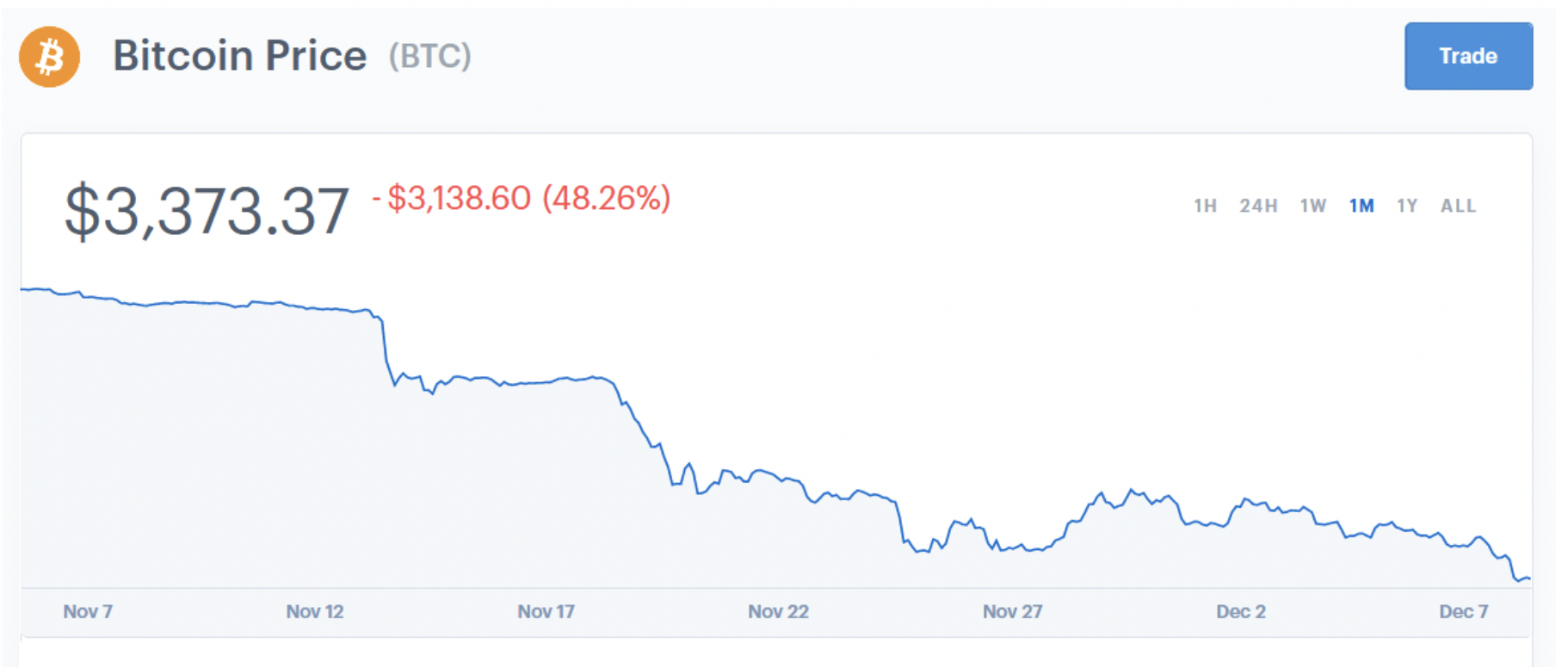About a decade ago, Warren Buffett famously wagered $1M against Ted Seides, CIO at Protégé Partners, that the S&P 500 would outperform a group of hedge funds over a 10-year stretch. Last year, the Oracle of Omaha collected his winnings after the market walloped a group of five hedge funds (undisclosed) hand-picked by Ted with a return of 85.4 percent vs. 22 percent.
And now, another asset manager is raring to go up against the stock market, but this time from cryptoland.
Anthony Pompliano, co-founder and partner at Morgan Creek Digital, has recreated Buffett's $1 million wager that he has dubbed "Buffett Bet 2.0" and invited any investor who believes the S&P 500 will beat the crypto market over the next decade to take the other side of the bet.
Anthony points out the erratic performance of the equities market this year, highlighted by heavy losses by tech and FANG stocks in recent months.
Never mind that the crypto market itself is in very bad shape right now, with bitcoin having plunged to a 14-month low on Friday.

(Click to enlarge)
Source: CNN Money

(Click to enlarge)
Source: Coinbase
Bear Market Looms?
Anthony’s bold bet is no doubt encouraged by the ominous signs that have been building up in the public equities market.
On Tuesday, the dreaded yield curve inversion rattled the markets after the 2-year Treasury yield crossed above the 10-year Treasury. A normal curve is one where the short-term 2-year and 3-year Treasuries offer a lower yield than the longer-term 5-year and 10-year notes. A yield curve inversion is said to occur when the 2-year or 3-year yields more than either or both the 5-year and 10-year Treasuries, signaling that the market believes the economy is going to be much worse in the future.
Indeed, all recessions since 1962 have been preceded by a yield curve inversion. The big inversion, where the 10-year yield slips below the 2-year, is usually considered the main harbinger of an economic contraction with a recession following on average 18 months after the event. In the case of a smaller inversion such as the current scenario, a recession takes longer to kick in—about 26.3 months on average. Related: Market Uncertainty Creates A Buying Opportunity For Gold
There are many reasons why investors fret over a yield curve inversion. One of the most important is that it can adversely affect bank lending to businesses, which in turn can choke economic growth. Banks usually borrow short-term at lower interest rates and make long-term loans to borrowers at higher rates with the spread being their profit. When short-term rates rise above long-term ones, it makes this model unfeasible for most loans and banks are forced to scale down their lending. This is one of the reasons why bank stocks entered a correction when an inversion happened on Tuesday.
In the meantime, stocks investors can take comfort in the fact that a yield curve inversion does not lead to immediate death for a bull market. Stocks can continue climbing for as many as 18 months after the event, though the arrival of a recession usually signals the end more often than not.
The big inversion is still quite some way off (the 10-year closed 11 bps above the 2-year Treasury on Thursday’s close), and the Fed’s recent dovish stance can help to at least slow down the decline.
Further, many pundits counter that an inversion is not relevant in the current era of massive interventions by central banks since it encourages foreign investors to keep scooping up U.S. bonds due to their more attractive yields compared to most foreign Treasuries.
Unchartered Crypto Territory
Anthony’s market challenge is interesting on two major fronts: hedge funds customarily underperform the market and also because cryptos are still unchartered territory.
Buffett’s win was by no means a fluke: Hedge funds have a dismal track record when it comes to matching or beating the market. In fact, past studies have shown that about 85 percent of fund managers underperform the market in any given year.
Crypto funds have been exploding according to Crypto Fund Research, with their managed assets set to double by the end of 2018. There’s no concrete data yet regarding the performance of these newish funds, though it’s probably safe to assume it’s not been anything to write home about given the terrible performance of the assets they track.
Related: Huawei Plummets As CFO Faces Extradition To The U.S.
Then again, it’s probably too early to pit cryptos against stocks given that the infantile industry is still descending into a trough of disillusionment following last year’s peak of inflated expectations (see Gartner’s Hype Cycle below).
According to PYMNTS.com, bitcoin payments dropped to just $96 million in September 2018 compared to a high of $427 million in December 2017. Until cryptos like bitcoin can gain mainstream acceptance as a means of exchange, it’s going to be tough for the market to grow in any appreciable way. Nobody knows how long this process will take.
On a positive note: 10 years is quite a long time, and a lot could change for the burgeoning industry.

(Click to enlarge)
Source: Gartner
By Alex Kimani for Safehaven.com
More Top Reads From Safehaven.com

















